Yufan Liu
Pay Less Attention to Deceptive Artifacts: Robust Detection of Compressed Deepfakes on Online Social Networks
Jun 25, 2025Abstract:With the rapid advancement of deep learning, particularly through generative adversarial networks (GANs) and diffusion models (DMs), AI-generated images, or ``deepfakes", have become nearly indistinguishable from real ones. These images are widely shared across Online Social Networks (OSNs), raising concerns about their misuse. Existing deepfake detection methods overlook the ``block effects" introduced by compression in OSNs, which obscure deepfake artifacts, and primarily focus on raw images, rarely encountered in real-world scenarios. To address these challenges, we propose PLADA (Pay Less Attention to Deceptive Artifacts), a novel framework designed to tackle the lack of paired data and the ineffective use of compressed images. PLADA consists of two core modules: Block Effect Eraser (B2E), which uses a dual-stage attention mechanism to handle block effects, and Open Data Aggregation (ODA), which processes both paired and unpaired data to improve detection. Extensive experiments across 26 datasets demonstrate that PLADA achieves a remarkable balance in deepfake detection, outperforming SoTA methods in detecting deepfakes on OSNs, even with limited paired data and compression. More importantly, this work introduces the ``block effect" as a critical factor in deepfake detection, providing a robust solution for open-world scenarios. Our code is available at https://github.com/ManyiLee/PLADA.
Hierarchical Semantic Compression for Consistent Image Semantic Restoration
Feb 24, 2025Abstract:The emerging semantic compression has been receiving increasing research efforts most recently, capable of achieving high fidelity restoration during compression, even at extremely low bitrates. However, existing semantic compression methods typically combine standard pipelines with either pre-defined or high-dimensional semantics, thus suffering from deficiency in compression. To address this issue, we propose a novel hierarchical semantic compression (HSC) framework that purely operates within intrinsic semantic spaces from generative models, which is able to achieve efficient compression for consistent semantic restoration. More specifically, we first analyse the entropy models for the semantic compression, which motivates us to employ a hierarchical architecture based on a newly developed general inversion encoder. Then, we propose the feature compression network (FCN) and semantic compression network (SCN), such that the middle-level semantic feature and core semantics are hierarchically compressed to restore both accuracy and consistency of image semantics, via an entropy model progressively shared by channel-wise context. Experimental results demonstrate that the proposed HSC framework achieves the state-of-the-art performance on subjective quality and consistency for human vision, together with superior performances on machine vision tasks given compressed bitstreams. This essentially coincides with human visual system in understanding images, thus providing a new framework for future image/video compression paradigms. Our code shall be released upon acceptance.
RealEra: Semantic-level Concept Erasure via Neighbor-Concept Mining
Oct 11, 2024

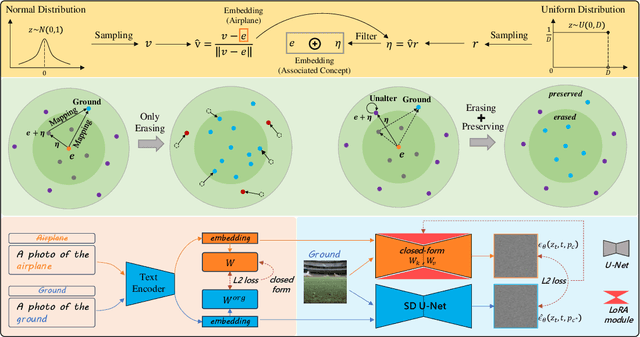
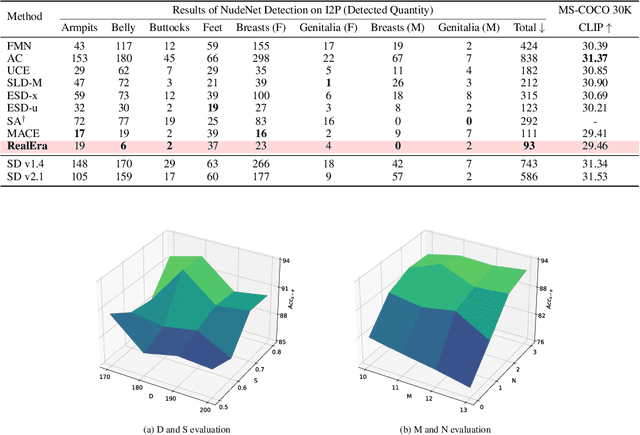
Abstract:The remarkable development of text-to-image generation models has raised notable security concerns, such as the infringement of portrait rights and the generation of inappropriate content. Concept erasure has been proposed to remove the model's knowledge about protected and inappropriate concepts. Although many methods have tried to balance the efficacy (erasing target concepts) and specificity (retaining irrelevant concepts), they can still generate abundant erasure concepts under the steering of semantically related inputs. In this work, we propose RealEra to address this "concept residue" issue. Specifically, we first introduce the mechanism of neighbor-concept mining, digging out the associated concepts by adding random perturbation into the embedding of erasure concept, thus expanding the erasing range and eliminating the generations even through associated concept inputs. Furthermore, to mitigate the negative impact on the generation of irrelevant concepts caused by the expansion of erasure scope, RealEra preserves the specificity through the beyond-concept regularization. This makes irrelevant concepts maintain their corresponding spatial position, thereby preserving their normal generation performance. We also employ the closed-form solution to optimize weights of U-Net for the cross-attention alignment, as well as the prediction noise alignment with the LoRA module. Extensive experiments on multiple benchmarks demonstrate that RealEra outperforms previous concept erasing methods in terms of superior erasing efficacy, specificity, and generality. More details are available on our project page https://realerasing.github.io/RealEra/ .
Token Caching for Diffusion Transformer Acceleration
Sep 27, 2024



Abstract:Diffusion transformers have gained substantial interest in diffusion generative modeling due to their outstanding performance. However, their high computational cost, arising from the quadratic computational complexity of attention mechanisms and multi-step inference, presents a significant bottleneck. To address this challenge, we propose TokenCache, a novel post-training acceleration method that leverages the token-based multi-block architecture of transformers to reduce redundant computations among tokens across inference steps. TokenCache specifically addresses three critical questions in the context of diffusion transformers: (1) which tokens should be pruned to eliminate redundancy, (2) which blocks should be targeted for efficient pruning, and (3) at which time steps caching should be applied to balance speed and quality. In response to these challenges, TokenCache introduces a Cache Predictor that assigns importance scores to tokens, enabling selective pruning without compromising model performance. Furthermore, we propose an adaptive block selection strategy to focus on blocks with minimal impact on the network's output, along with a Two-Phase Round-Robin (TPRR) scheduling policy to optimize caching intervals throughout the denoising process. Experimental results across various models demonstrate that TokenCache achieves an effective trade-off between generation quality and inference speed for diffusion transformers. Our code will be publicly available.
Prediction Exposes Your Face: Black-box Model Inversion via Prediction Alignment
Jul 11, 2024Abstract:Model inversion (MI) attack reconstructs the private training data of a target model given its output, posing a significant threat to deep learning models and data privacy. On one hand, most of existing MI methods focus on searching for latent codes to represent the target identity, yet this iterative optimization-based scheme consumes a huge number of queries to the target model, making it unrealistic especially in black-box scenario. On the other hand, some training-based methods launch an attack through a single forward inference, whereas failing to directly learn high-level mappings from prediction vectors to images. Addressing these limitations, we propose a novel Prediction-to-Image (P2I) method for black-box MI attack. Specifically, we introduce the Prediction Alignment Encoder to map the target model's output prediction into the latent code of StyleGAN. In this way, prediction vector space can be well aligned with the more disentangled latent space, thus establishing a connection between prediction vectors and the semantic facial features. During the attack phase, we further design the Aligned Ensemble Attack scheme to integrate complementary facial attributes of target identity for better reconstruction. Experimental results show that our method outperforms other SOTAs, e.g.,compared with RLB-MI, our method improves attack accuracy by 8.5% and reduces query numbers by 99% on dataset CelebA.
Distributed Invariant Kalman Filter for Cooperative Localization using Matrix Lie Groups
May 07, 2024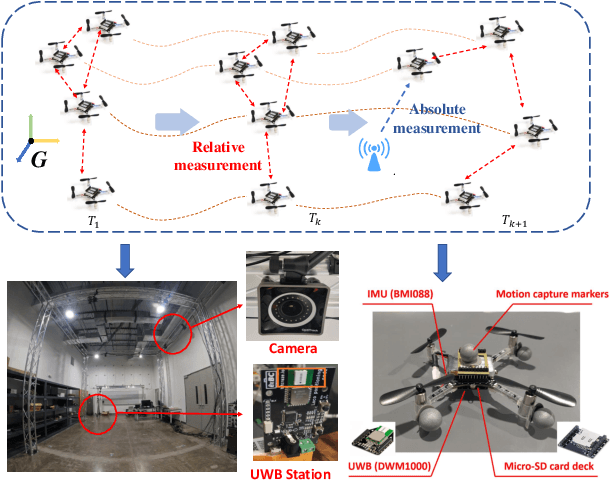

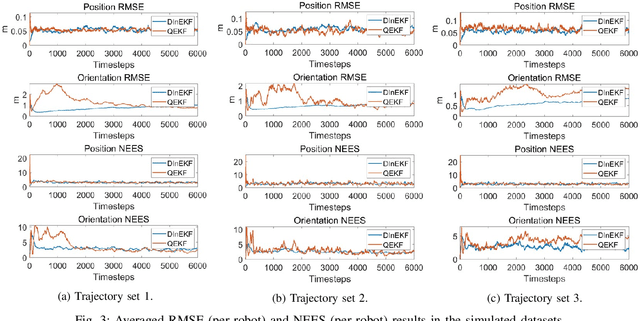

Abstract:This paper studies the problem of Cooperative Localization (CL) for multi-robot systems, where a group of mobile robots jointly localize themselves by using measurements from onboard sensors and shared information from other robots. We propose a novel distributed invariant Kalman Filter (DInEKF) based on the Lie group theory, to solve the CL problem in a 3-D environment. Unlike the standard EKF which computes the Jacobians based on the linearization at the state estimate, DInEKF defines the robots' motion model on matrix Lie groups and offers the advantage of state estimate-independent Jacobians. This significantly improves the consistency of the estimator. Moreover, the proposed algorithm is fully distributed, relying solely on each robot's ego-motion measurements and information received from its one-hop communication neighbors. The effectiveness of the proposed algorithm is validated in both Monte-Carlo simulations and real-world experiments. The results show that the proposed DInEKF outperforms the standard distributed EKF in terms of both accuracy and consistency.
Learning to Route Among Specialized Experts for Zero-Shot Generalization
Feb 08, 2024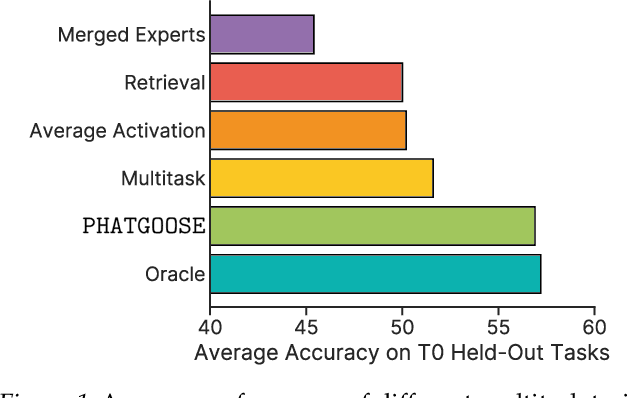



Abstract:Recently, there has been a widespread proliferation of "expert" language models that are specialized to a specific task or domain through parameter-efficient fine-tuning. How can we recycle large collections of expert language models to improve zero-shot generalization to unseen tasks? In this work, we propose Post-Hoc Adaptive Tokenwise Gating Over an Ocean of Specialized Experts (PHATGOOSE), which learns to route among specialized modules that were produced through parameter-efficient fine-tuning. Unlike past methods that learn to route among specialized models, PHATGOOSE explores the possibility that zero-shot generalization will be improved if different experts can be adaptively chosen for each token and at each layer in the model. Crucially, our method is post-hoc - it does not require simultaneous access to the datasets used to create the specialized models and only requires a modest amount of additional compute after each expert model is trained. In experiments covering a range of specialized model collections and zero-shot generalization benchmarks, we find that PHATGOOSE outperforms past methods for post-hoc routing and, in some cases, outperforms explicit multitask training (which requires simultaneous data access). To better understand the routing strategy learned by PHATGOOSE, we perform qualitative experiments to validate that PHATGOOSE's performance stems from its ability to make adaptive per-token and per-module expert choices. We release all of our code to support future work on improving zero-shot generalization by recycling specialized experts.
Cross-Architecture Knowledge Distillation
Jul 12, 2022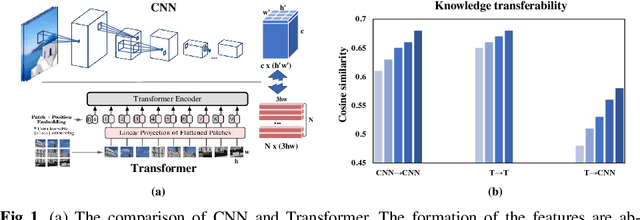
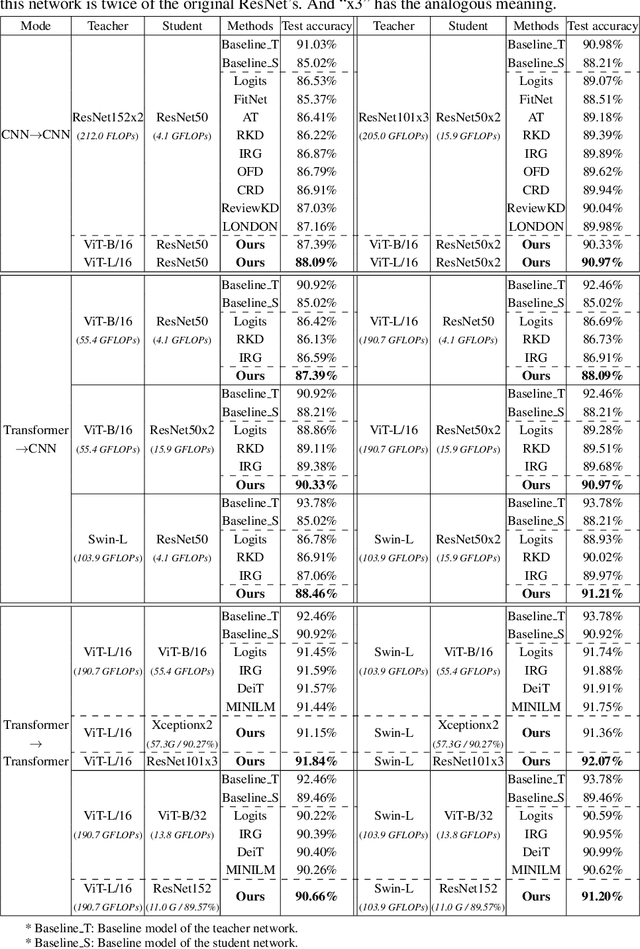

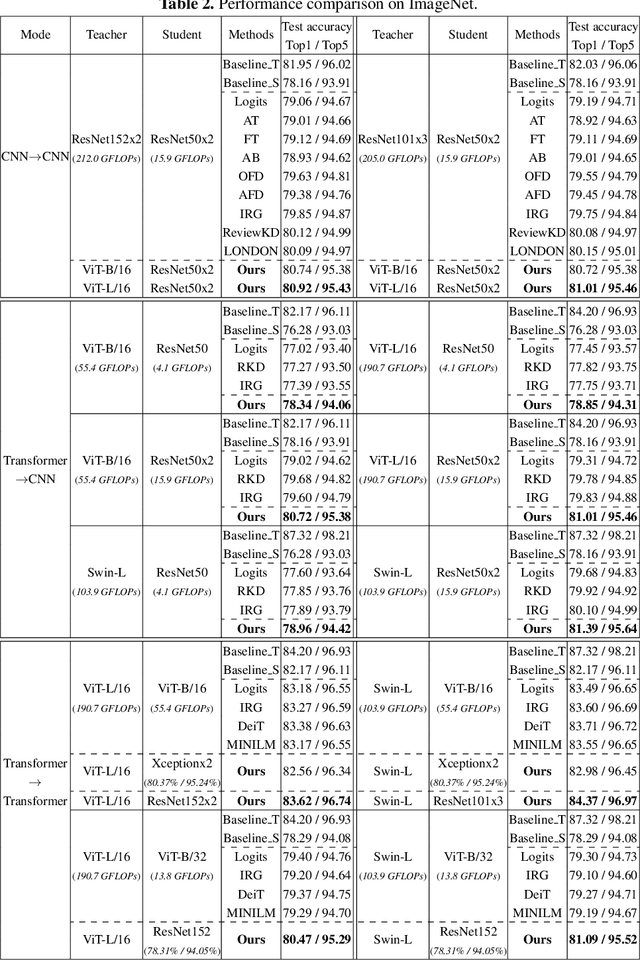
Abstract:Transformer attracts much attention because of its ability to learn global relations and superior performance. In order to achieve higher performance, it is natural to distill complementary knowledge from Transformer to convolutional neural network (CNN). However, most existing knowledge distillation methods only consider homologous-architecture distillation, such as distilling knowledge from CNN to CNN. They may not be suitable when applying to cross-architecture scenarios, such as from Transformer to CNN. To deal with this problem, a novel cross-architecture knowledge distillation method is proposed. Specifically, instead of directly mimicking output/intermediate features of the teacher, a partially cross attention projector and a group-wise linear projector are introduced to align the student features with the teacher's in two projected feature spaces. And a multi-view robust training scheme is further presented to improve the robustness and stability of the framework. Extensive experiments show that the proposed method outperforms 14 state-of-the-arts on both small-scale and large-scale datasets.
Joint Learning of Visual-Audio Saliency Prediction and Sound Source Localization on Multi-face Videos
Nov 05, 2021



Abstract:Visual and audio events simultaneously occur and both attract attention. However, most existing saliency prediction works ignore the influence of audio and only consider vision modality. In this paper, we propose a multitask learning method for visual-audio saliency prediction and sound source localization on multi-face video by leveraging visual, audio and face information. Specifically, we first introduce a large-scale database of multi-face video in visual-audio condition (MVVA), containing eye-tracking data and sound source annotations. Using this database, we find that sound influences human attention, and conversly attention offers a cue to determine sound source on multi-face video. Guided by these findings, a visual-audio multi-task network (VAM-Net) is introduced to predict saliency and locate sound source. VAM-Net consists of three branches corresponding to visual, audio and face modalities. Visual branch has a two-stream architecture to capture spatial and temporal information. Face and audio branches encode audio signals and faces, respectively. Finally, a spatio-temporal multi-modal graph (STMG) is constructed to model the interaction among multiple faces. With joint optimization of these branches, the intrinsic correlation of the tasks of saliency prediction and sound source localization is utilized and their performance is boosted by each other. Experiments show that the proposed method outperforms 12 state-of-the-art saliency prediction methods, and achieves competitive results in sound source localization.
SDTP: Semantic-aware Decoupled Transformer Pyramid for Dense Image Prediction
Sep 18, 2021



Abstract:Although transformer has achieved great progress on computer vision tasks, the scale variation in dense image prediction is still the key challenge. Few effective multi-scale techniques are applied in transformer and there are two main limitations in the current methods. On one hand, self-attention module in vanilla transformer fails to sufficiently exploit the diversity of semantic information because of its rigid mechanism. On the other hand, it is hard to build attention and interaction among different levels due to the heavy computational burden. To alleviate this problem, we first revisit multi-scale problem in dense prediction, verifying the significance of diverse semantic representation and multi-scale interaction, and exploring the adaptation of transformer to pyramidal structure. Inspired by these findings, we propose a novel Semantic-aware Decoupled Transformer Pyramid (SDTP) for dense image prediction, consisting of Intra-level Semantic Promotion (ISP), Cross-level Decoupled Interaction (CDI) and Attention Refinement Function (ARF). ISP explores the semantic diversity in different receptive space. CDI builds the global attention and interaction among different levels in decoupled space which also solves the problem of heavy computation. Besides, ARF is further added to refine the attention in transformer. Experimental results demonstrate the validity and generality of the proposed method, which outperforms the state-of-the-art by a significant margin in dense image prediction tasks. Furthermore, the proposed components are all plug-and-play, which can be embedded in other methods.
 Add to Chrome
Add to Chrome Add to Firefox
Add to Firefox Add to Edge
Add to Edge